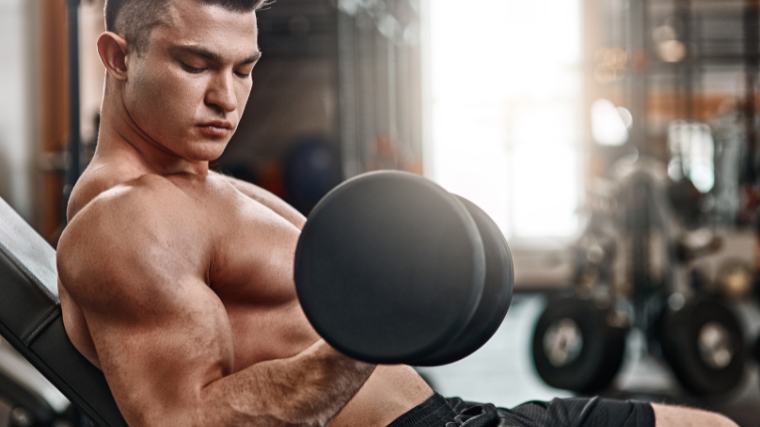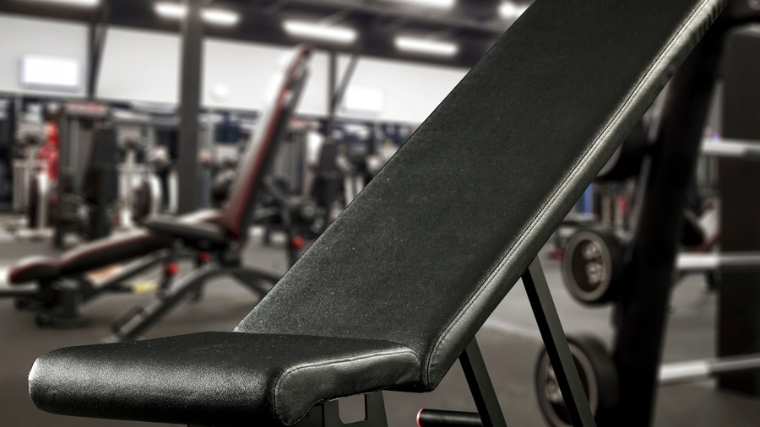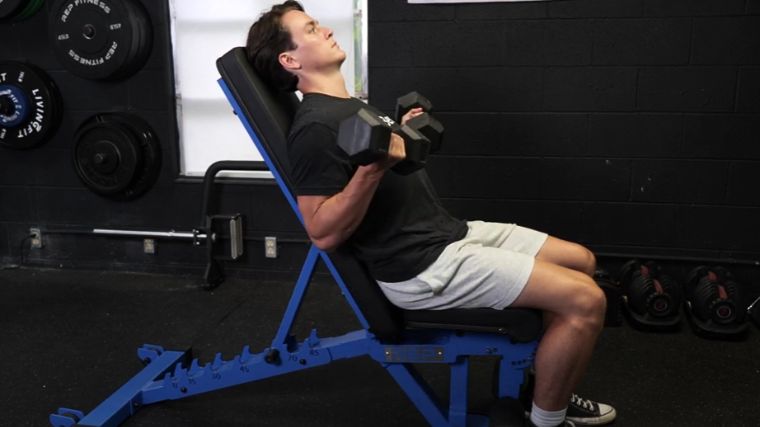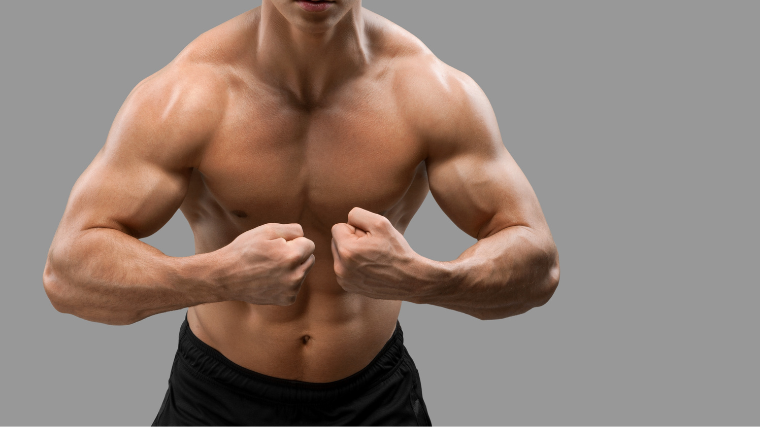Your arm workouts aren’t supposed to be a walk in the park. Growing your guns takes focus, grit, work ethic, and, maybe more than anything, the right exercises.
By its very design, the incline dumbbell curl places you in a prime position to squeeze more juice out of your biceps so they can grow as fast as possible. It’s a surprisingly challenging — but scarily effective — exercise that your arm days might just be sorely lacking.

Here’s how to do it properly, why it works, and how to include it into your routine for maximal muscle gain.
How to Do the Incline Dumbbell Curl
Luckily, the incline dumbbell curl is a pretty grab-and-go exercise. To get started, all you’ll need are a pair of dumbbells and an adjustable (this is essential) weight bench.
Step 1 — Set and Sit

Adjust the bench to a high, but not fully perpendicular to the floor, angle. Think between 45 and 65 degrees relative to the floor. From here, take a seat with the dumbbells in your hands. Lean back against the pad and allow your arms to hang down at your sides, perpendicular to the floor.
Step 2 — Curl and Squeeze

Once you’re set up, perform a standard dumbbell curl. Your arms must remain behind your torso while you’re on the bench. Think about keeping your elbows back while you curl the weights up as high as possible.
Incline Dumbbell Curl Sets and Reps
As a small, single-joint isolation movement, your programming options for the incline curl are somewhat narrow. Your best bet is to avoid trying to force the movement into a purpose it isn’t suited for.
- If You’re a Beginner: Try 3 sets of 10 reps with a moderate weight.
- For Muscle Growth: Go for 3 to 4 sets of 8 to 12 reps focusing on a strong contraction and training to near-failure.
Common Incline Dumbbell Curl Mistakes
Isolation movements are pretty straightforward. After all, only one joint is loaded at a time. That said, you should always make sure you’re dialed in on the smallest aspects of your form if you want to make the biggest gains.
Setting the Bench Too Low
The hallmark feature of the incline curl is, well, the incline bench you rest on. This aspect of the exercise is critical because it allows you to curl with your arm behind your torso.
You don’t need to overdo it, though. If you set the inclination of the bench too low, you’re likely going to feel the most tension in the front of your shoulder, rather than in your biceps where it belongs.
Drifting Your Arm Forward
To maximally engage both heads of the biceps during the incline dumbbell curl, your upper arm needs to remain fixed behind your body for the duration of the exercise.
If your arm is pulled forward as you curl the weight, you’re actually reducing some of the stretch and tension placed on the tissue. Keep your elbows pinned back and tucked against the bench for the duration of the set.
Incline Dumbbell Curl Variations
You can make some small tweaks to the setup or execution of the incline curl depending on your needs in the gym. Here are a couple of suitable variations to try on for size.
Incline Dumbbell Hammer Curl
The incline hammer curl is far more similar to the standard incline curl than it is different. The only notable change will be the angle of your hand as you perform the movement.
By curling with a neutral (palms facing inward) grip, you can lessen the tension on the biceps somewhat and involve your brachialis, brachioradialis, and the other smaller muscles in your forearms to a greater degree.
Incline Zottman Curl
You can get the biceps-focused stimulation of the standard incline curl and the forearm tension from a hammer curl by performing the Zottman curl instead.
This niche movement involves twisting your wrists to turn the dumbbell over as you lower it from the top of each repetition. Doing so will test your grip and isometric strength during the eccentric phase of the exercise, so hold on tight.
Incline Dumbbell Curl Alternatives
You don’t need to perform the incline curl itself to crush your arms in a similar fashion. As long as you can find a movement that somewhat replicates the posture, feel free to swap it out for one of these alternatives.
Drag Curl

The drag curl isn’t an exercise you’ll often see in an arm workout, but it works wonders as a substitute for the incline curl.
Drag curls look like regular standing barbell curls, but with the distinct difference that you intentionally pull your elbows backward as you “drag” the bar up your body.
You’ll find that this motion mimics the arm-behind-the-torso posture that makes the incline curl so fantastic for biceps growth. As a side perk, you can also lift pretty heavy on the drag curl.
Facing-Away Cable Curl
This movement doesn’t have one distinct name, but it’s pretty easy to identify and perform. As long as you have access to an adjustable cable machine, you can replicate the arm posture of the incline curl and work with cables instead.
The big benefit here is the constant mechanical tension provided by the cable itself. Where the incline dumbbell curl generally becomes quite easy once your forearm is past parallel to the floor, you’ll find that the facing-away cable curl is equally torturous from top to bottom.
Muscles Worked by the Incline Dumbbell Curl
Your biceps, end of story. Well, not really, but don’t make the mistake of thinking that the vast majority of curls serve any other purpose than the (very) noble pursuit of beefing up your arms.
Still, a comprehensive understanding of your own anatomy might spur you to plug the incline curl into your workout program.
Biceps
Your biceps brachii is a very straightforward bit of muscle tissue. Located on the front surface of your upper arm, this two-headed muscle serves to bend, or flex, your elbow joint. That is its primary (and for all practical purposes, only) function.
However, note that the biceps is actually a biarticular muscle — it crosses both the elbow and shoulder joints. As such, adjusting one of those joints can automatically affect the tension placed upon the tissue overall.

[Read More: Best Upper Chest Exercises for Building Muscle]
By allowing your arm to fall behind your torso, a motion called shoulder hyperextension, you’ll find that your biceps are instantaneously stretched. Think pulling a resistance band apart; same idea.
As such, curling in this position forces you to contract a very stretched, highly-tense tissue. This will compromise your leverage, making even a light weight feel quite heavy, and also incur a lot of muscle damage along the way. That’s the magic of the incline curl.
Benefits of the Incline Dumbbell Curl
It won’t wine and dine you, but the incline curl will help you build your arms in a way that other biceps exercises simply can’t.
Builds Your Arms
Not only will the incline curl help you grow your biceps, but it will do so in a way you simply cannot get from certain other exercises.
Make no mistake; you don’t strictly need an arm-behind-the-torso curl variation in your workout routine if you want to grow. However, it does provide a unique stimulus.
If you’re after arm gains and want to ensure every single base is covered during your workouts, the incline curl should be in the conversation.
Easy to Learn, Easy to Master
Some exercises are simple enough to perform adequately but have steep learning curves on the way to mastery. This isn’t the case for the incline dumbbell curl.
There are some small technical aspects that will separate you from a first-timer (keeping your elbows pinned back, finding the exact right height for your bench), but it’s a no-frills movement for the most part.
You can get the hang of it in a single session, and be more than comfortable making it a mainstay movement in a few weeks’ time.
Can Be Trained Unilaterally
All dumbbell-based exercises provide you the luxury of working one side of your body independently from the other.
Single-sided exercises allow you to focus on working the target muscle without worrying about balance or stability. More importantly, you can identify and address any imbalances in muscular size or strength.
There’s no law saying you need perform the incline curl with both arms working at the same time. Feel free to alternate them, or even work one side at a time altogether.
Who Should Do the Incline Dumbbell Curl
Want to grow your arms? Check. New to the gym? Check. Need to remedy a muscle imbalance? All the more reason to make the incline curl a mainline movement.
Those Pursuing Muscle Gain
If you want to build muscle, you need to make your muscles work. High muscular tension is integral to kickstarting the process of hypertrophy.
In that regard, an exercise like the incline dumbbell curl is a fantastic choice because it compromises your leverages and makes even a light dumbbell feel incredibly challenging.
Beginners
The incline dumbbell curl may be more intricate than, say, a standing curl, but it is by no means off-limits to newer gymgoers.

After all, you’re performing the exercise while sitting down. As long as you can do so comfortably, the incline curl is a perfectly good choice for your first-ever biceps exercise.
If You Want to Avoid Imbalances
Make no mistake, working with a bilateral implement like a barbell isn’t a pathway to muscle imbalances. In fact, barbell training comes with a wide swath of benefits, so don’t overlook it, even for your arms.
That said, some lifters will develop discrepancies in their muscularity, strength, or mobility over time. Working with a variety of dumbbell-based movements may help prevent this from occurring, since each arm (or leg) has to pull, or curl in this case, its own weight.
Sit Back and Enjoy the Gains
Sitting down isn’t synonymous with relaxation — especially not in the weight room. Standing curls are all well and good, but the incline dumbbell curl is in a league of its own when it comes to muscle stimulation.
The posture, setup, and execution of the incline curl are features you can’t really find in many other places. There’s a buffet of biceps exercises on the table, and they’re all worth sampling. But the incline dumbbell curl is definitely worth sitting down and digging into.
Frequently Asked Questions
Still stuck on whether the incline curl is right for you? Put those worries to bed.
Is the incline dumbbell curl a mandatory movement?
No exercise is mandatory unless you compete in a strength sport. When designing a workout routine, you should select exercises that are fun, comfortable, and that challenge you.
If you don’t like the incline curl or it causes you discomfort, you don’t have to do it.
How high should I adjust the bench for the incline dumbbell curl?
There’s definitely a sweet spot, but it will vary from person to person. Your best bet is to start a bit higher and maybe lower the bench if you find it provides a better stretch and contraction.
However, lower than about 40 degrees could cause shoulder discomfort or take tension off the biceps, so be careful.
Featured Image: Podushko Alexander / Shutterstock